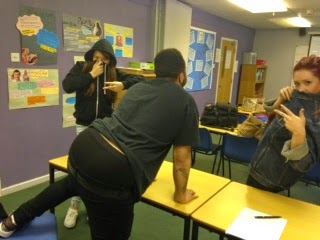'Parody is imitation, not always at the expense of the parodied text' Linda Hutcheon
A parody is an imitative work created to imitate, comment on or trivialise an original work, its subject, author, style, or some other target by means of satiric or ironic imitation.
In one of our lesson, we were given the task to go and imitate a specific genre of music videos and take photos of our parodies. We chose to make a parody of a rap/hip-hop video as this is the most distinctive genre, and we thought not only would it be easy to do, but funny. We found it harder than we thought as it seemed that everyone thought the same way and we suddenly found it difficult to come up with original ideas.
 Firstly, we chose to take a photo in front of a whiteboard in the sixth form. We thought this was funny because hip hop videos are mostly filmed in front of graffiti, and are often advertising themselves or the writing includes censored words. We used words and phrases one would generally call silly than anything else, and posed covering our mouths as this is what rappers are often seen doing.
Firstly, we chose to take a photo in front of a whiteboard in the sixth form. We thought this was funny because hip hop videos are mostly filmed in front of graffiti, and are often advertising themselves or the writing includes censored words. We used words and phrases one would generally call silly than anything else, and posed covering our mouths as this is what rappers are often seen doing.
The next shot we took was outside of a convenience store next to our sixth form. Using hand gestures to show off the £6 sign, we thought this was ironic as hip hop videos often boast and show off about how much money they have, and champagne is also featured often. I think this links with Rick Altman's theory, as rap videos have easily recognisable features to connect with the audience, or in this case, show off. Once again we covered our mouths and Amy made sure her hood was up as this is typical rapper attire. This happens to link with Steve Neale's theory of repetition in music videos. We liked two shots that took as one was front a typical low angle used in rap and hip hop videos to make the artist look bigger and more powerful, and in both we had eye contact and we looking straight into the camera.
When we first went outside, we were looking for some graffiti to pose in front of. We couldn't find any except for on this subway sign. We thought this would be ironic as usually the graffiti is on high buildings, compared to the small sign. As well, lots of rap/hip hop videos are filmed in underpasses in front of graffiti and in the dark. We made a joke out of all these aspects through this photo.
In the rap videos we have analysed in class, we found that there was always some form of money involved in shots. However, this is always in vast quantities and in note form. We came up with the idea of using any spare change and dropping it on the floor whilst Amy tried to take a picture. We did this to imitate showing off our money, even though we don't really have any in the photo. It is taken from a low angle as we are crouched on a table to emphasise this stereotype.
Finally, we decided to include the fact that women are often used to be promiscuous in rappers videos, and are not used for much else. As we are a group of girls this is obviously really annoying and upsetting, so we agreed to turn it around and asked our guy friend to dance with his behind facing the camera, as this is usually the only angle of women that we see. Amy and I pose in the background of this, but in reality, the dancers and women are usually only in the background of the video as they are only seen as an extra and a proof of wealth and success. This is one of Goodwin's features of music videos called the notion of looking, and is an incredibly common feature of many genres of music videos.









































